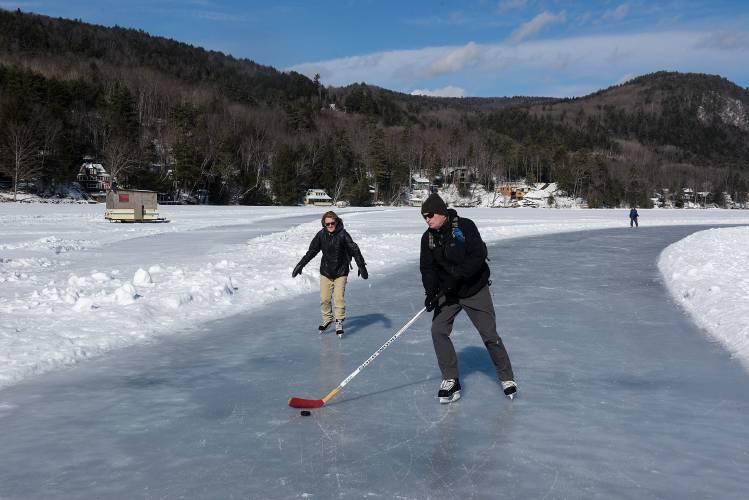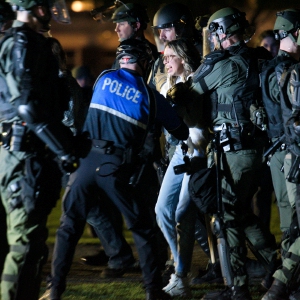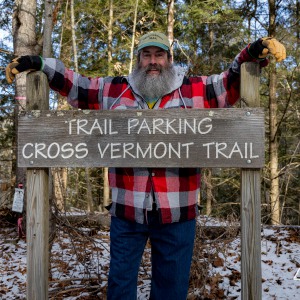Out & About: Thin ice puts future of Upper Valley skating trails in jeopardy

Sue Haidul, left, and her husband Joe, right, of Boston, skate a short trail on Lake Morey as the 4.3-mile ice skating trail around the lake, splitting off at left, remains closed on Friday, Feb. 11, 2022. This season's variable temperatures and wet snow frozen into the surface of the ice have made the longer trail difficult to maintain. (Valley News - James M. Patterson) Copyright Valley News. May not be reprinted or used online without permission. Send requests to permission@vnews.com. Valley News file — James M. Patterson
| Published: 04-13-2024 10:29 AM |
ENFIELD — The Mascoma Lake Skating Association was founded in 2020 with high hopes.
“We wanted to bring about something that people could enjoy, especially during COVID times and get outside,” said Bridget Labrie, a member of the nonprofit organization’s board, which plowed its first ice skating loops in early 2021. “We had two really great years.”
That luck changed the last two winters as thin ice and inconsistent cold weather made creating a trail on the lake that spans the Lebanon and Enfield border nearly impossible. Warmer winters are especially challenging for organizations like Mascoma Lake Skating Association and Northeast Slopes in East Corinth, which rely on natural ice or snow.
In the case of Mascoma, there’s nothing volunteers can do to make the ice stay frozen and reliable. This March, board members made the decision to stop accepting donations and take a “wait and see” approach to plowing a trail next winter. The board declined to say how much money they have remaining.
“With the climate changing and the impact it’s having on those winter sports, especially up here in New England, it’s having a pretty profound impact on the lakes and ponds freezing — or not,” Labrie, of Enfield, said. “Depending on the end of next year (2025), we’ll revisit whether we keep trying or disband.”
In addition to paying an equipment operator to maintain the trail, the nonprofit organization also pays for a port-a-potty on nearby Shakoma Beach and to have the Shakoma Beach parking lot plowed — located across the street on Route 4A — so skaters have a place to park. Each time there was a snowstorm that covered the ice, it cost around $2,000 to plow the parking lot and the ice skating trail, Labrie said. Depending on the year, the loops ranged from 1 to 3 miles.
“We’ve learned we have to be flexible and decided to try to pursue a strategy that we can plow if and when it makes sense to,” she added, meaning they are looking to have people with ATVs with plows who can respond and work quickly if and when good ice conditions present themselves.
Matt Steinberg, a board member who checks the ice thickness to see if it is thick enough for the plowing equipment, said that a strong layer of around 8 inches of black ice is necessary for safety before the trail can be put in place.
Article continues after...
Yesterday's Most Read Articles
 Hundreds of alumni sign letter urging Beilock, Dartmouth to make a stand for academic freedom
Hundreds of alumni sign letter urging Beilock, Dartmouth to make a stand for academic freedom
 Kenyon: A year later, effects of mass arrests at Dartmouth linger
Kenyon: A year later, effects of mass arrests at Dartmouth linger
 ‘A bit Kafkaesque’: Federal judge spars with government lawyer over status of Dartmouth international student
‘A bit Kafkaesque’: Federal judge spars with government lawyer over status of Dartmouth international student
 Woodstock demotes police chief to patrol officer
Woodstock demotes police chief to patrol officer
 High school baseball: Windsor rebuilds while Thetford shines
High school baseball: Windsor rebuilds while Thetford shines
 Outgoing Alice Peck Day CEO led hospital through growth and change
Outgoing Alice Peck Day CEO led hospital through growth and change
“We need the consistent cold weather early in the season to set that base of black ice,” said Steinberg, an experienced Nordic ice skater who travels all over the state for outdoor skating. “Once we get into our rain and snow events, that will build layers onto that black ice.”
The first year, 2021, that was the case: Steinberg, of Enfield, said there was 18 inches of ice in middle of the lake and 30 inches closer to the shore.
By comparison, he said Mascoma did not freeze until early January this year and when it did, he measured only 2 inches of black ice “which is not really enough to handle the rain and the snow that came afterwards.”
There was around 7 inches of white ice — which comes from snow and rain storms, is porous and contains more air — on the lake this winter, Steinberg said.
“It’s not nearly as strong and it can’t support the plow we need to clear the snow,” he said.
Challenging ice conditions in recent years also have affected the outdoor ice skating trail maintained by Lake Morey Resort in Fairlee.
“The last two years our season has been pretty short,” said Paige Radney, resort experience manager. “I think we got in four weeks of skating this year.”
During good years, the trail typically opens Martin Luther King Jr. Day weekend in mid-January. In the past couple of years, it has not opened until around the first weekend of February. In winter 2023, the loop was around 1½ miles and this winter it was around 3¾ miles, which was better than the previous year. During a good ice year, that is closer to 4½ miles and stays frozen for a longer length of time.
“I think it’s going to be a lot of ‘take what you can get,’ ” Radney said. “We stay hopeful because it’s such a huge part of our tradition here.”
Ice needs to be at least 6 inches to support the resort’s equipment, which includes a four-wheeler equipped with a brusher to clear and smooth the ice, Radney said. For larger and heavier equipment such as trucks and plows, the ice needs to be around a foot thick.
This year, the ice reached 8 inches toward the middle of the lake and 6½ to 7 inches throughout the rest of the lake.
“Typically if it’s less than five inches we don’t really encourage people to go out,” Radney said. “It’s safe to stand on with one or two inches, but once you get a lot of people out there, the more weight you put on the ice the more it’s going to push the ice down so it becomes less and less safe.”
In spite of the challenges, dedicated Nordic ice skaters like Steinberg are trying to take the recent warm winters in stride.
“I’m not worried we will never have a winter again when we have two feet of ice out there. I think we will. The problem is it’s not as predictable as it used to be,” Steinberg said. “It’s sort of cross our fingers and hope everything falls into place.”
Liz Sauchelli can be reached at esauchelli@vnews.com or 603-727-3221.






 A Life: Larry Flint ‘just chose to focus on the positive’
A Life: Larry Flint ‘just chose to focus on the positive’ Local Roundup: Mascoma baseball narrowly loses to Fall Mountain
Local Roundup: Mascoma baseball narrowly loses to Fall Mountain  Cross Vermont Trail expands into nearby communities with connector to Lamoille Valley Rail Trail
Cross Vermont Trail expands into nearby communities with connector to Lamoille Valley Rail Trail
